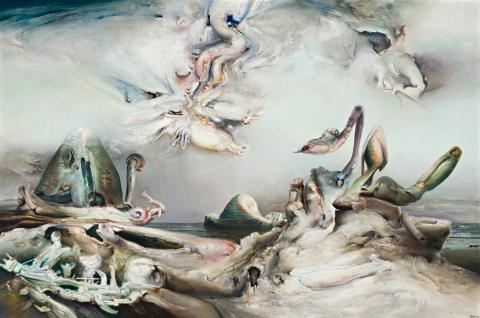THE PROPITIOUS MOMENT, 1987
James Gleeson
oil on canvas
182.5 x 274.0 cm
signed and dated lower right: Gleeson ‘87
signed and inscribed with title verso: The Propitious Moment / James Gleeson
Watters Gallery, Sydney
Private collection, Sydney
James Gleeson, Fifteen Recent Paintings, Watters Gallery, Sydney, 16 March – 9 April 1988, cat. 4
In 1983, James Gleeson turned to painting full-time. Prior to that date, he had given decades of his life to others - over twenty years had been spent writing art reviews for the Sydney Sun and Sun Herald, books on his artist-friends William Dobell and Robert Klippel, and innumerable other subjects. He was director of the Sir William Dobell Foundation, an inaugural member of the Visual Arts Board, visiting curator at the National Gallery of Australia and a member of the Gallery's first Council. Among other things, Gleeson was the 1972 Australian Commissioner at the 12th Bienal de Sao Paulo, Brazil, and a judge of the Tokyo International Biennial of Prints. His painting, of necessity, had been a part-time affair, although his output was such that in thirty-two years he held seventeen solo exhibitions throughout much of Australia. Since placing his art first, his output has been enormous, the number of works completed over the following twenty-five years nearing one thousand - and all are masterly. To call him prolific is an understatement. There have been allied changes in style and approach. His technique has become more fluent as he painted bigger pictures, and the human figure, which was the focus of earlier attention, played an ever-decreasing role until it was dropped altogether, as in this work. Gleeson described this outpouring of creativity as 'like catching a wave, adding 'it's flowed on pretty consistently ever since.'1
The Propitious Moment, 1987, was painted in the first years of this creative surge. Like its title, the painting of the moment was a propitious omen. An important influence was that of J. M. W. Turner, especially in light, colour and atmosphere. Many of Gleeson's paintings recall the grandeur if not also the imaginative wonder of such Turner paintings as Ulysses Deriding Polyphemus, Homer's Odyssey, 1829, and Sunrise with Sea Monsters, c.1845, with its images rising from the subconscious. Although Gleeson paints from the imagination, there are passages in The Propitious Moment, especially of the sea and shore, which are like direct transcripts of plein air painting. Technical brilliance and a low horizon to heighten the drama are the hallmarks of Surrealism, which, in the hands of Australia's greatest practitioner of the genre evokes notions of grandeur and the sublime. Crustaceous and biomorphic creatures emerge from the geology of the shore: an island of the imagination reveals its oyster-like being, and the skies above are filled with descending shapes from the apocalypse. It is vintage Gleeson.
1. The artist, quoted in McDonald, J., Studio: Australian Painters on the Nature of Creativity, R. Ian Lloyd Productions Pte Ltd, Singapore, 2007, p. 74
DAVID THOMAS
